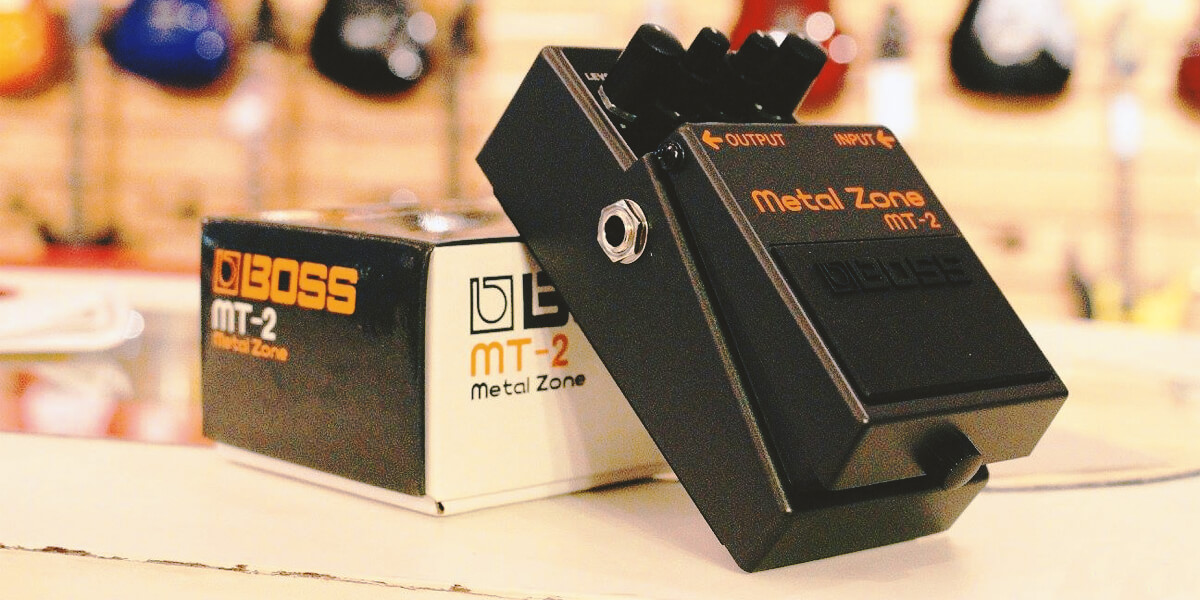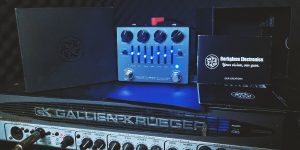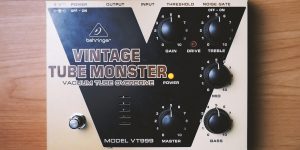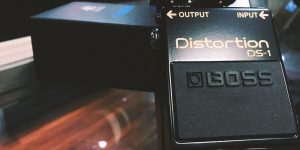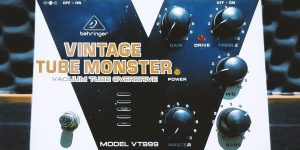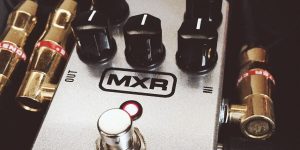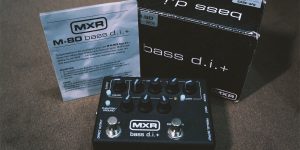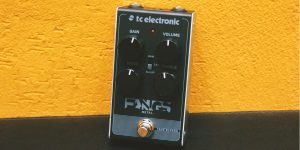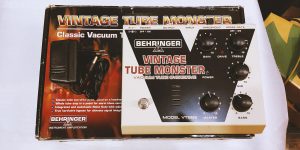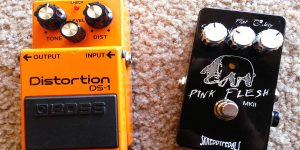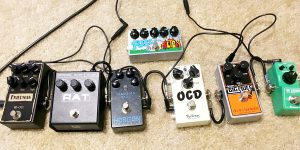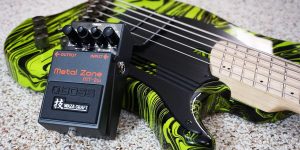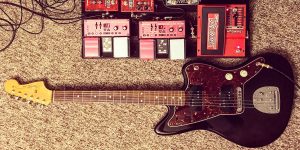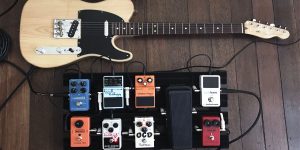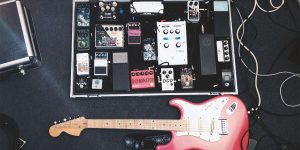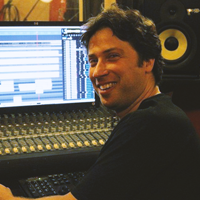Of course, not every pedal is marked for a particular style. But you can say so about it if you know the genres and have heard the effect. So here I will tell you about the best distortion pedals for Death Metal, which are clearly more suitable for performing this style than others. I’m sure, once you try it, you will agree with it.
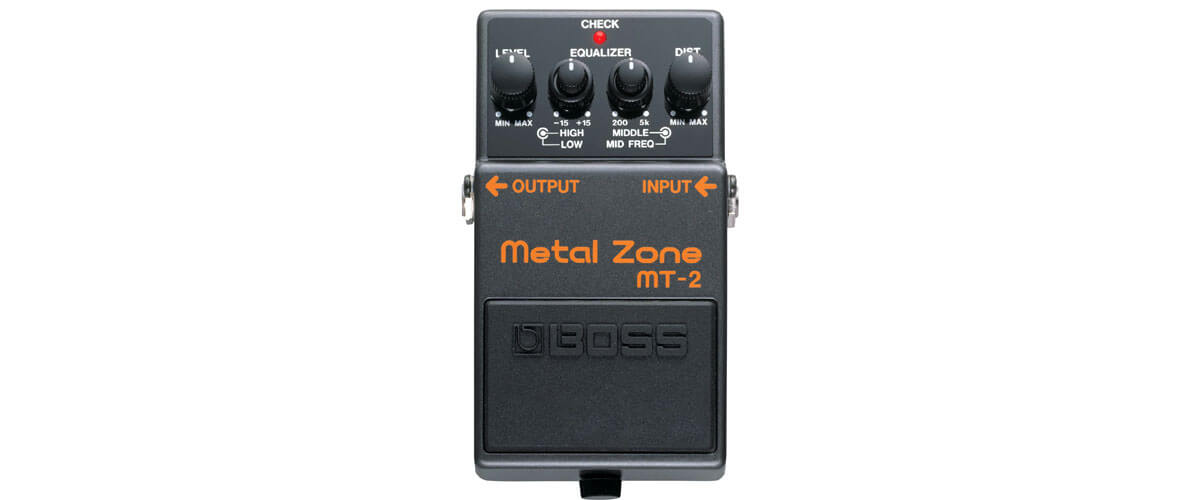
Distortion pedal for death metal comparison table
| Name | Controls | Connectors | Power Supply | Review |
|---|---|---|---|---|
| Boss MT-2 best overall | pedal switch, tone, level, dist, EQ mid freq, EQ high/low freq | input jack: 1/4-inch, output jack: 1/4-inch, DC IN jack | Alkaline battery (9V, 6LR61) or Carbon-zinc battery (9V, 6F22), AC adaptor | Review |
| Pro Co RAT2 | pedal switch, filter, volume, distortion | input jack: 1/4-inch, output jack: 1/4-inch, DC IN jack | battery (9V), DC adaptor (9V) | Review |
| TC Electronic Fangs Metal Distortion | pedal switch, gain, volume, bass, treble, raw/scoop | input jack: 1/4-inch, output jack: 1/4-inch, DC IN jack | battery (9V), DC adaptor (9V) | Review |
What distortion type to choose?
Basically, Overdrive, Distortion, and Fuzz are pedals that produce an overdriven guitar sound, and they differ only in level. Even a Super Metal pedal can be adjusted to play less harsh styles (for example, pop). On the contrary – not always, although you can turn the Gain up to the limit and achieve the sound suitable for metal.
Each distortion has a unique tone, and it is the most important detail for the performance of this or that style or even a separate composition. So, in the end, it all depends on what exactly you want to play. Heavy metal implies thick, rich lower frequencies. High punchy frequencies are good for Extreme Metal, and clear open mids for Punk and Hard Rock. So experiment, try more different options, and you will find your sound.
Best distortion pedal for death metal reviews
Boss MT-2 – best overall
In this Boss MT-2 review, I will tell you about one of the most famous pedals but, at the same time, controversial pedals. All guitarists know it, but it has earned absolutely opposite feedback during its history. By the way, this model was released in 1991 but is still one of the best-selling models. Let's look at the Metal Zone MT-2 features; they may help you decide whether this pedal is suitable for you. Already from the name is clear, the distortion pedal will be more for fans of the Metal genre. Even in this case, I recommend hearing it first because the Boss MT-2 sounds specific.
Build and design

All musicians know Boss pedals as being "eternal" and unbreakable because they are made of durable metal and have a rubberized switch. They last long, and they really do, so you can safely buy the Metal Zone for frequent concert performances. Plus, it weighs 14 oz and measures 2-7/8 inches, 5-1/8 inches, and 2-3/8 inches, making it compact. The MT-2 Metal Zone is as easy to use as most Boss pedals. All 4 knobs are on the front panel and are conveniently located. I will tell you about them in the next paragraph. In addition, there is an on/off pedal, two jacks on the sides, and a CHECK indicator (used to indicate the presence of a check battery). You set this pedal once before using it, and don't touch it again during playing.
Features
The Boss MT-2 is a pedal with a two-stage distortion circuit and multiband EQ and has a lot of tuning and gain options. You may like it or not, but it is a good device with great features. And whether you like the result of the sound is up to you.
So, we have 4 knobs, and among them, there's no TONE, which is usual for distortion pedals. But instead, we have two EQUALIZER knobs. The EQUALIZER HIGH/LOW knob controls the standard high and low frequencies. The second EQUALIZER MIDDLE/MID FREQ knob is a feature of the MT-2, and once you figure it out and adjust it, you'll reach a new level of overdrive. You'll have to struggle to tune it; the minimal deviations will make your guitar sound different. But the result is sure to impress the listener as well: real, heavy metal, everything is on point here. The DIST and LEVEL knobs do their direct job of boosting volume and distortion.
This model also has True-Bypass, which directs the guitar signal from the input directly to the output. So you can turn the pedal off in a chain without the danger of damaging the instrument. But this only works with small circuits; otherwise, the timbre will dissipate. The Metal Zone can run from a Carbon-zinc battery (9 V, 6F22) or with a Boss PSA 9v power adapter, which you have to buy separately.
Sound
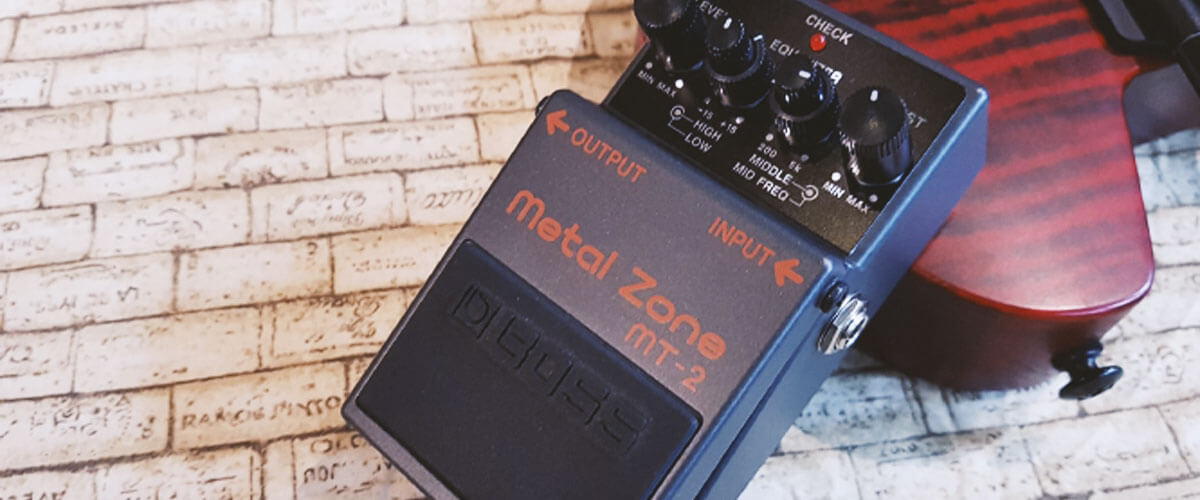
It seems to me that the ambiguous attitude to the Boss MT-2 Metal Zone is connected exactly with its sound because it's hard to complain about the functions. You can achieve extremely aggressive tones worthy of legendary compositions with the right tuning. Indeed, the factory settings are scary-sounding, but with enough time and effort, you can get metal riffs, Metallica-style rhythm tones, and unbelievable gain levels. What else do you need from a distortion pedal? All in all, it's not a device for the lazy ones. But there are still those who don't appreciate the result, and that's because there are no people with the same tastes. Definitely, it will be appreciated by fans of heavy stuff, but it will be good among the guitarists of other genres. So try it, listen to it, and experiment with it. Everything will work out!
Key specs
- Controls: pedal switch, tone, level, dist, EQ mid freq, EQ high/low freq.
- Connectors: input jack: 1/4-inch, output jack: 1/4-inch, DC IN jack.
- Power Supply: Alkaline battery (9V, 6LR61) or Carbon-zinc battery (9V, 6F22), AC adaptor.
- Size (WxDxH), inch/cm: 2.8x2.3x5/7.3x12.9x5.9
- Weight oz/g: 14/385.
All experienced guitarists know it. The Boss MT-2 was released in 1991 but is still among the most popular. You can achieve extremely aggressive tones worthy of legendary works with the right tuning. By spending enough time and effort to tune it, you will be able to play metal riffs and Metallica-style rhythm tones and get an unbelievable level of amplification. It is undoubtedly the best distortion pedal for Death Metal.
Pro Co RAT2
In 1978, in the basement of a Pro Co store in Kalamazoo, Michigan, Scott Burmam created an effect pedal. This device has undergone some changes since then, but the original circuitry has remained the same. And today, in the Pro Co RAT2 review, I will tell you about this now-famous pedal made by the Chinese company Neutrik for Pro Co. It is designed for fuzz and distortion in equal measure, where smoothness overrides sharpness. So let's take a closer look at it.
Build and design
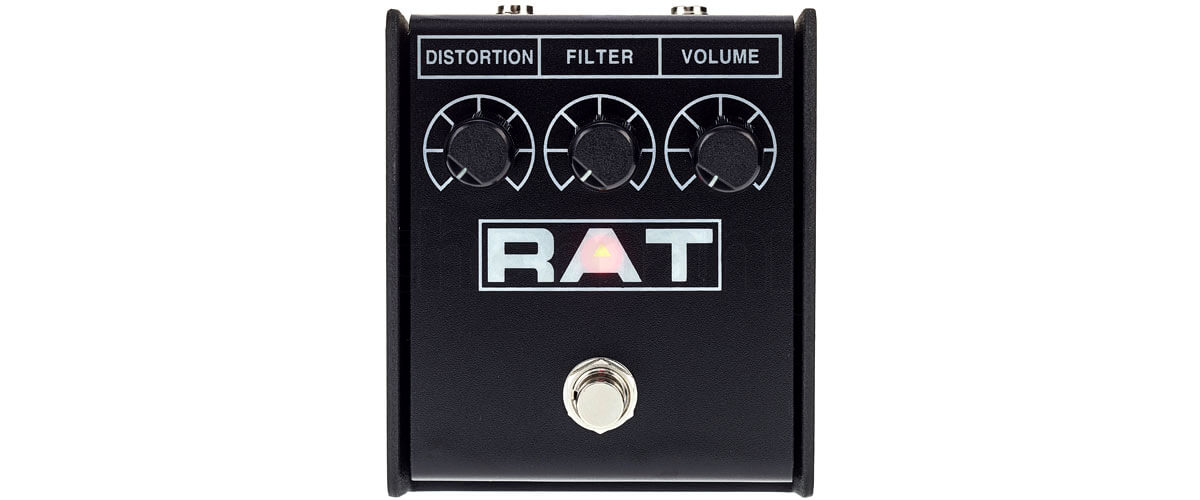
The cute little pedal has an understated design in black with glow-in-the-dark graphics. So it's visible on your pedalboard in the dark. The Rat 2 gives the impression of being indestructible, and it really is. Measuring 2.5 inches, 3.5 inches, and 4 inches, and weighing 2 pounds, it has a classic practical steel body and metal panels on the sides. The heavy-duty industrial pedal switches, three knobs, and connectors can also handle a lot, making it definitely suitable for concert activities. Circuit connectors are located on the top panel of the sidewall next to the DC connector, and there is also an On/Off LED indicator and a battery compartment on the back. Everything is simple and to the point.
Features
Pro Co RAT2 features are as simple as its design. But that doesn't stop it from being versatile. To start with, the pedal runs on 9V batteries and the RPS2 power supply adapter, which are not included in the kit. In addition, it has standard ¼" jacks, a 100% analog signal path, a military-grade glass-epoxy circuit board, and a True Bypass. There are also three controls, Distortion, Volume, and Filter, which rotate virtually 360 degrees, allowing for an extremely wide range of tuning.
As I said before, the pedal finds a balance somewhere between distortion and fuzz. Indeed, by turning the knob to the limit, you can get one effect or another, depending on what you're playing. The Filter is designed to regulate high and low frequencies. All in all, by playing around with the settings, you will get unexpected results. But take your time. Better yet, listen to RAT2 before you buy it. In my opinion and musical taste, it is perfect for classic rock or grunge. But metal lovers will find it lacking in dirt and compression.
Sound
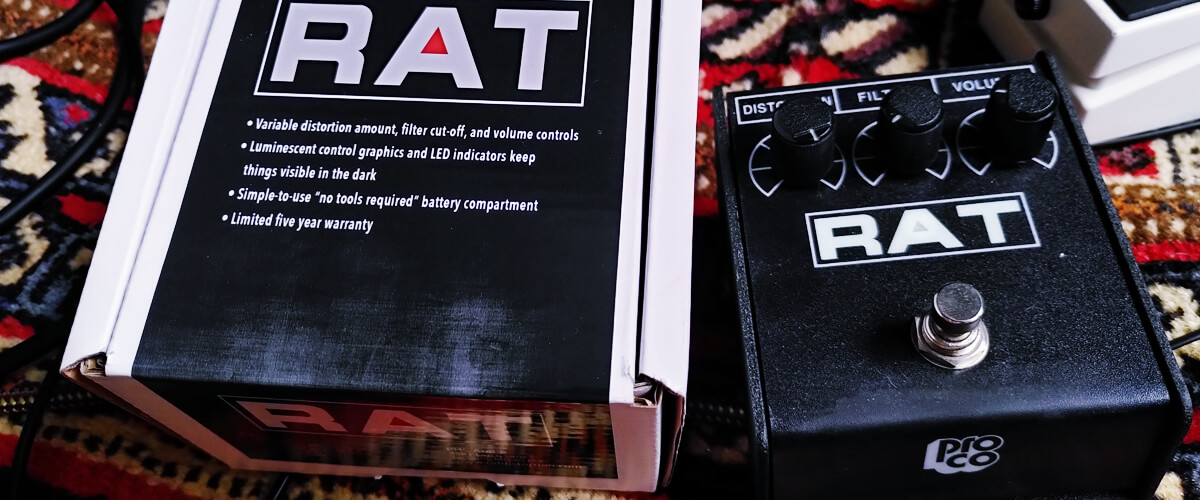
In conclusion, I can only say one thing: this pedal will undoubtedly find its fans, even though it does not have any one unique quality. It's all about the range of its capabilities. It is definitely not suitable for heavy styles of music, but in grunge, classic rock Pro Co RAT2 sounds great. The proof of that is the fact that Kurt Cobain used it. And he's not the only one! Thom Yorke, James Hetfield, and David Gilmour are also among the users. If you take the time to experiment with its knobs, tune it, and play it back, the RAT2 will give you the credit you deserve. And taking into account its affordable price, I can put it in a worthy competitive place among other pedals.
Key specs
- Controls: pedal switch, filter, volume, distortion.
- Connectors: input jack: 1/4-inch, output jack: 1/4-inch, DC IN jack.
- Power Supply: battery (9V), DC adaptor (9V).
- Size (WxDxH), inch/cm: 3.5x4x2.5/8.8x10.1x6.3.
- Weight oz/g: 32/907.
Created in 1978 in the basement of a Pro Co store in Kalamazoo, Michigan, the pedal has undergone some changes since then, but the original circuitry has remained the same. Today it is designed for fuzz and distortion and is a great death metal guitar pedal. If you take the time to experiment with its knobs, tune it, and play different variations, the RAT2 will reward you for your hard work.
TC Electronic Fangs Metal Distortion
The Danish company TC Electronic is well known for its musical instruments and related devices, which include a wide range of effects pedals. Today, in my TC Electronic Fangs Metal Distortion review, I offer you a simple pedal that has only one purpose - gain, gain, and more gain. It creates a range from thick walls of distortion doom metal to ultra-dense thrash tones. So if you're a fan of heavy genres of music - you've come to the right place. Let's go!
Build and design
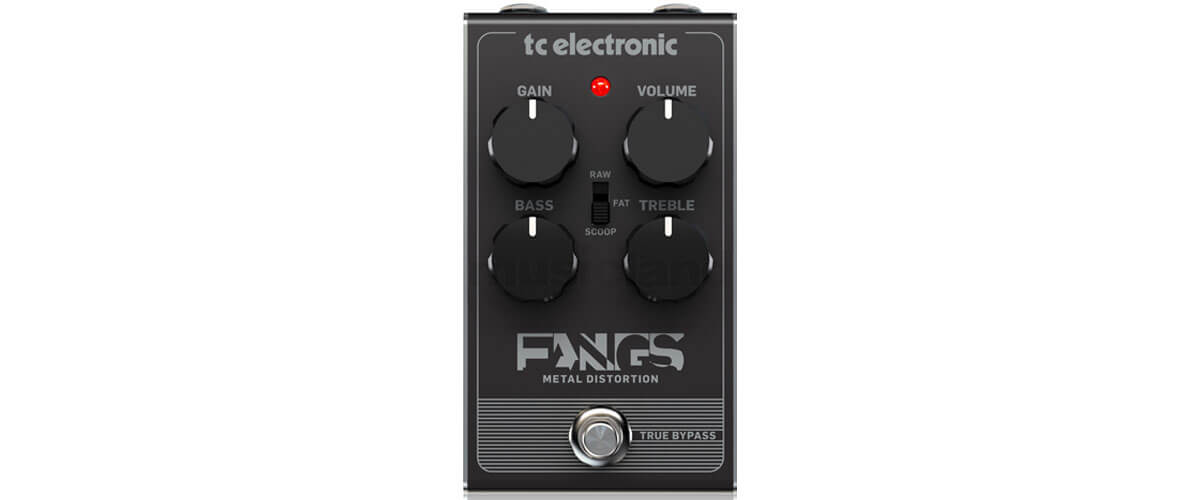
Fangs Metal Distortion has a simple, understated design. The black metal body is designed for distortion, meaning you can jump on it endlessly - it's tough as a tank. The pedal is compact and relatively lightweight. It weighs 1.1 lbs and measures 2.3" x 2.9" x 5.2", so you can move it around effortlessly.
There are standard 1/4" Input and Output jacks on the case to connect to your pedalboard with a jack to connect a 9V DC power supply, which is not included. The front panel has a metal round True Bypass button, Bass, Volume, Treble, Gain pots, and Raw/Scoop Switch. As you can see, everything is simple. But is it so regarding TC Electronic Fangs Metal Distortion features? Let's take a look.
Features
Despite its sole purpose, Fangs Metal is versatile in the distortion range. Incredibly low level. Bass and Treble EQ combined with each other have an amplitude from low-gain crunch to modern metal (from 9 o'clock to 3 o'clock). The controls are very comfortable and smooth, and I enjoyed it while experimenting with the sound.
The 3-position Raw/Fat/Scoop selector is an excellent midrange response, which provides a transition between raw classic metal tones, scooped nu-metal, and up to super beefy sludge metal tones. Scoop mode is mega-compressed hard thrash, '80s/'90s death metal. Add to that the True Bypass switching, which keeps your tone when the pedal is off, and enjoy!
Sound
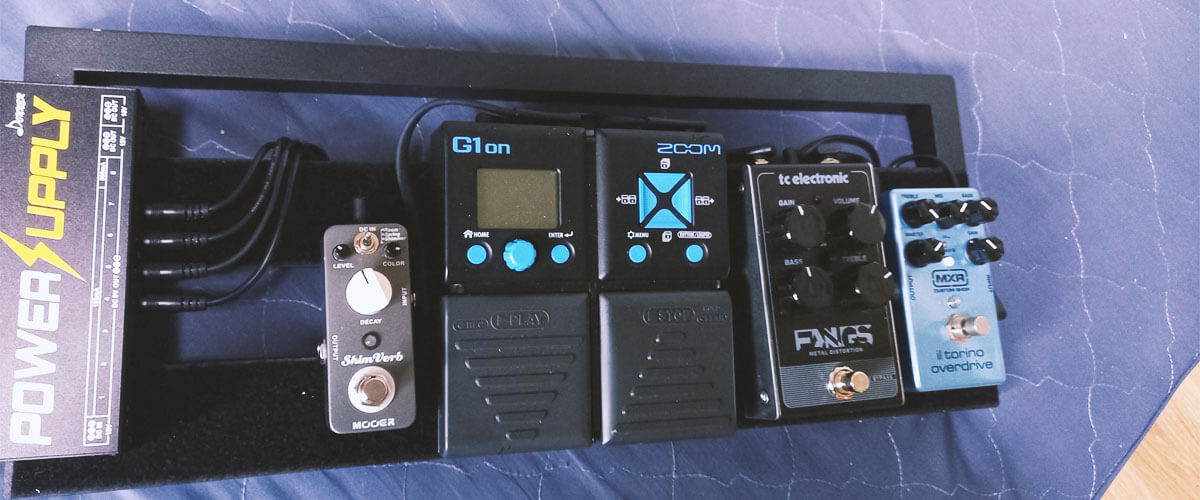
TC Electronic Fangs Metal Distortion sounds aggressive, crushing, and stunning. You'll find tight and frenetic rhythm tones and searing solo sounds. The pedal instruments will let you just sail through the timbres of true prog-metal, doom-metal, baby-metal, high metal, and '80s hard rock.
I rarely advise anything insistently because I think everyone is free to choose for themselves, but for its value, Fangs Metal Distortion is a godsend for metal players. Honestly, I would rank it with distortion pedals from Boss, MXR, and EHX. Add the size to its sound and price, and you get something you really need to have in your arsenal.
Key specs
- Controls: pedal switch, gain, volume, bass, treble, raw/scoop.
- Connectors: input jack: 1/4-inch, output jack: 1/4-inch, DC IN jack.
- Power Supply: battery (9V), DC adaptor (9V).
- Size (WxDxH), inch/cm: 2.9x5.2x2.3/7.4x13.2x5.8.
- Weight oz/g: 17.6/500.
This pedal has only one purpose – amplification, amplification, and more amplification. It creates a range from thick walls of distortion doom-metal to ultra-dense thrash tones. TC Electronic Fangs Metal Distortion sounds aggressive, crushing, and stunning. You’ll find dense and frenetic rhythm tones and searing solo sounds. It is the best brutal distortion pedal!

